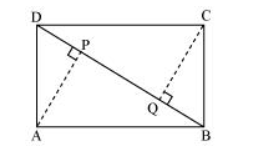ABCD is a parallelogram and AP and CQ are perpendiculars from vertices A and C on diagonal BD (See the given figure). Show that<br/><br/>(i) ΔAPB ≅ ΔCQD<br/><br/>(ii) AP = CQ

(i) In $\triangle \mathrm{APB}$ and $\triangle \mathrm{CQD}$,
$\angle \mathrm{APB}=\angle \mathrm{CQD}\left(\right.$ Each $\left.90^{\circ}\right)$
$A B=C D$ (Opposite sides of parallelogram $A B C D$ )
$\angle A B P=\angle C D Q$ (Alternate interior angles for $A B \| C D$ )
$\therefore \triangle \mathrm{APB} \cong \triangle \mathrm{CQD}$ (By AAS congruency)
(ii) By using the above result
$\triangle \mathrm{APB} \cong \triangle \mathrm{CQD}$, we obtain
$\mathrm{AP}=\mathrm{CQ}(\mathrm{By} \mathrm{CPCT})$
Click here to get exam-ready with eSaral
For making your preparation journey smoother of JEE, NEET and Class 8 to 10, grab our app now.
